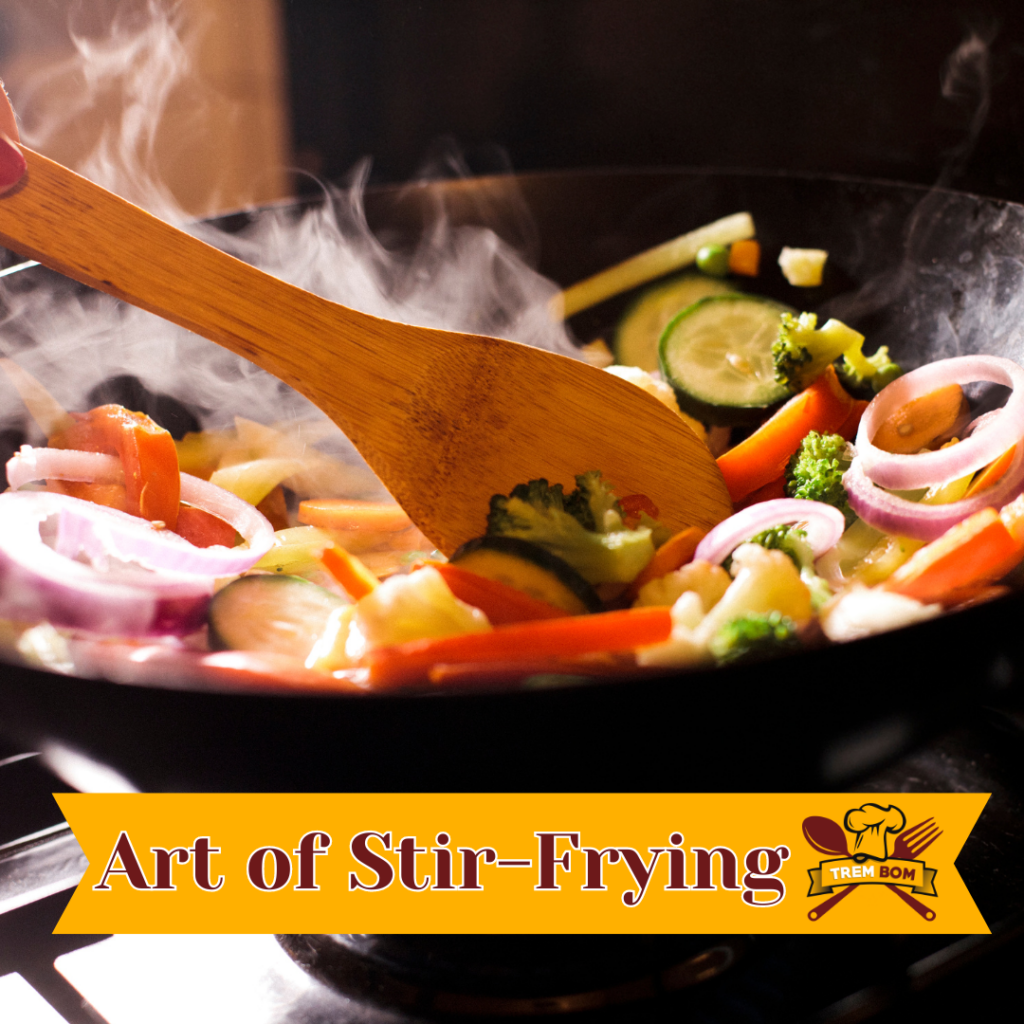
Stir-frying is an art that requires skill and precision. It involves cooking food quickly over high heat in a wok with a small amount of oil. The result is a dish that is crispy, flavorful, and healthy. Whether you are a novice or an experienced chef, perfecting your stir-fry technique is essential to creating delicious meals.
Key Takeaways:
- Stir-frying involves cooking food quickly over high heat with a small amount of oil.
- The wok is the essential tool in stir-frying.
- High heat is crucial for successful stir-frying.
- Tossing is an essential technique that ensures all ingredients are evenly cooked.
- Practicing and experimenting are the keys to mastering the art of stir-frying.
The Importance of a Good Wok and High Heat
When it comes to stir-frying, a good wok and high heat are essential elements. Woks are versatile and can be used to cook a wide range of dishes, making them a must-have tool in any kitchen. Stir-frying allows you to cook food quickly and evenly, while also preserving the nutrients and flavors.
The key to a successful stir-fry is a hot wok and high heat. When the wok is heated properly, it creates a unique flavor known as wok hei. To achieve the perfect wok hei, it’s important to heat the wok until it starts to smoke slightly before adding the oil. This ensures that the wok is hot enough to sear the ingredients and create that unmistakable aroma.
It’s worth noting that the temperature of the wok should be maintained throughout the cooking process. If the wok starts to cool down, it can affect the cooking time and the overall flavor and texture of the dish. To prevent this from happening, it’s recommended to cook in small batches and allow the wok to reheat between each batch. Alternatively, you can cool down the wok slightly by adding a small amount of cool water before wiping it dry and reheating it with oil.
Another important factor to consider is the type of wok you’re using. Traditional carbon steel woks are popular for their durability and ability to heat up quickly, but they require seasoning to prevent rusting and sticking. Stainless steel woks, on the other hand, are low-maintenance but may not heat up as well as carbon steel. Cast iron woks are also an option, but they tend to be heavier and take longer to heat up.
In conclusion, a good wok and high heat are crucial for successful stir-frying. By using the right tools and techniques, you can achieve the perfect wok hei and create delicious stir-fried dishes that are sure to impress.
Essential Ingredients and Cooking Techniques
When it comes to stir-frying, having the right ingredients and knowing how to cook them is crucial for achieving a delicious result. Here are some essential ingredients and cooking techniques to keep in mind:
Stir-Fry Sauce
A good stir-fry sauce should be a balance of salty, sweet, and savory flavors. To make a basic stir-fry sauce, mix together light soy sauce, oyster sauce, and a bit of sugar. You can also add sesame oil for extra flavor. Cornstarch is commonly used to thicken the sauce and give it a glossy texture.
Marinade
Marinating your meat before cooking can help tenderize it and add flavor. Mix together light soy sauce, cornstarch, and a bit of oil to make a simple marinade.
Velveting
Velveting is a technique in which meat is marinated and then quickly blanched in boiling water or oil before stir-frying. This results in a more tender and juicy texture. To velvet meat, mix together egg white, cornstarch, and a bit of oil. Toss the meat in the mixture and let it sit for a few minutes before blanching and stir-frying.
Pound of Meat
When stir-frying meat, it’s important to slice it thinly and pound it with a meat mallet to tenderize it further. This results in a more even and flavorful cook.
Sesame Oil
Sesame oil is a flavorful ingredient commonly used in stir-fries. It should be added towards the end of cooking to prevent burning.
Stir-Fry Ingredients
When choosing ingredients for your stir-fry, it’s important to consider the size and shape of each ingredient. Cut them into uniform sizes to ensure even cooking. Vegetables like broccoli and carrots should be blanched before stir-frying to soften them up.
By using the right ingredients and cooking techniques, you can create delicious and flavorful stir-fries at home.
Perfecting Your Stir-Fry Technique
To create a perfect stir-fry, it’s crucial to master the art of tossing and searing. Once the wok is heated, add oil to the bottom, swirl it around, and wait for it to heat up until it’s lightly smoking.
Begin by searing the meat. Add it to the bottom of the wok and let it cook undisturbed for about a minute before tossing it. Then, add in your vegetables, starting with the ones that take the longest to cook.
When it’s time to toss, use a quick and snappy motion to flip the ingredients. This distributes the heat evenly and prevents sticking. Be sure to scrape the sides of the wok as you toss to prevent burning.
A trick to achieving the perfect sizzle is to add scallions to the wok before the rest of the ingredients. The moisture from the scallions creates steam, which helps distribute the heat and prevent sticking.
Finally, garnish your stir-fried dish with something bright and fresh, like cilantro or sliced chili peppers. This adds color and flavor, making it more appealing to the eye and tastebuds.
With these techniques, you can create a delicious and perfectly stir-fried dish every time.
Tips for Superior Stir-Frying at Home
Stir-frying is a popular cooking technique that can be easily mastered by home cooks with the right guidance. Here are some tips for creating a proper stir-fry:
- Size and shape: Cut all the ingredients into uniform size and shape to ensure even cooking.
- Preheat the wok: Heat up the wok for a few minutes on high heat before adding the cooking oil. This will prevent the ingredients from sticking to the surface.
- Cook fast: Stir-fry dishes should be cooked quickly over high heat to prevent overcooking and retain the flavors and textures of the ingredients.
- Cooking oil: Choose an oil with a high smoke point, such as peanut or avocado oil, to prevent the oil from burning and smoking.
With these tips, you can create delicious stir-fries at home that are just as good as those from your favorite restaurant.
Enhancing Flavors and Textures
One of the critical aspects of the art of stir-frying is knowing how to balance the various flavors and textures in a single dish. The layer of flavor is gradually built up by adding aromatics, sauces, and stocks, creating a depth of taste that is unmatched by any other cooking method.
Some of the essential ingredients used to enhance the flavors and textures of stir-fries include sesame oil, soy sauce, chicken stock, peanut oil, and avocado oil. For example, a few drops of sesame oil can add nutty undertones to a dish, while an extra spoonful of soy sauce can make it saltier and more savory. Chicken stock can be used as a base for the sauce, providing a rich umami flavor, and peanut and avocado oils can lend a subtle yet distinct flavor to the stir-fried ingredients.
Another critical tip for enhancing flavors is to use aromatics such as garlic, ginger, and scallion. These ingredients add a depth of flavor to the dish and can be stir-fried at the beginning to infuse the oil with their essence.
Overall, mastering the art of balancing flavors and textures takes practice, creativity, and experimentation. But once you understand the basics, you can create delicious stir-fried dishes that are uniquely yours.
Mastering Chinese Stir-Fry Techniques
If you’re looking to master the art of stir-frying, delving into the techniques used by Chinese chefs can be a great place to start. Chinese cooking places a strong emphasis on the harmony of flavors, textures, and aromas, making stir-frying an essential cooking method for Chinese dishes.
Chinese stir-fry typically involves cooking over high heat and using a wok to achieve the perfect level of browning and tenderness. To get the most out of your stir-fry, it’s important to use the right amount of oil and heat up the wok until it’s lightly smoking before adding ingredients.
| Ingredient | Function |
|---|---|
| Arrowroot | As a thickener for stir-fry sauces |
Chinese chefs often use arrowroot as a thickener for their stir-fry sauces. Arrowroot is a flavorless powder that helps to thicken the sauce without adding a starchy taste.
Another common technique used in Chinese stir-fry is “velveting” the meat. This involves marinating the meat with a combination of cornstarch, light soy sauce, and rice wine to create a layer of flavor and texture.
By incorporating these Chinese stir-fry techniques into your cooking, you can elevate the taste and texture of your dishes to new heights.
Exploring Unique Stir-Fry Recipes
If you’re looking to elevate your stir-fry game and try something new, look no further than these unique recipes and techniques from renowned chefs and culinary experts.
New York Times food columnist Grace Young is an expert on Chinese cooking and has shared numerous flavorful stir-fry recipes over the years. One of her most popular recipes is a stir-fry with bean sprouts and many other ingredients, including pork, ginger, garlic, scallions, and sherry. The dish is packed with texture and flavor, making it a true standout.
Another notable expert in the field of stir-fry is Kenji from The Food Lab. His recipe for stir-fried beef with broccoli is a true masterpiece, featuring tender slices of beef, crisp broccoli florets, and a savory sauce made with oyster sauce, soy sauce, and chicken stock.
When trying out new stir-fry recipes, it’s important to have the right tools and to follow the proper techniques. Make sure your wok is hot and well-seasoned, and be sure to prepare all your ingredients in advance so that you can cook quickly and efficiently.
By experimenting with unique ingredients and techniques, you can create stir-fries that are truly one-of-a-kind and bursting with flavor. So why not get creative and try something new tonight?
Conclusion
Stir-frying is an art as well as a science that requires practice and experimentation to perfect. We hope this article has provided you with valuable insights into the essential tools, cooking techniques, and tips to create delicious stir-fried meals.
Remember, a good wok and high heat are crucial for successful stir-frying. Season and maintain your wok properly for optimal performance and achieve the coveted wok hei for a unique flavor.
Master the art of stir-fry technique by understanding the importance of tossing, searing, and cooking each ingredient correctly. Use the right size and shape of ingredients, preheat the wok, and select the ideal cooking oil to make your stir-fries a success.
Enhance the taste and texture of your stir-fried dishes by adding different oils, seasonings, and stocks. Explore traditional Chinese stir-fry methods, unique recipes, and techniques from renowned chefs and culinary experts.
Practice Makes Perfect
Don’t be afraid to experiment and let your creativity run wild in the kitchen. With practice, you’ll be able to create restaurant-quality stir-fries that are delicious and satisfying.
So, get your wok ready and start stir-frying! Enjoy the delicious results of your stir-fry adventures and share them with your loved ones. Bon appétit!
FAQ
What is stir-frying?
Stir-frying is a cooking technique that involves quickly cooking small, uniform-sized pieces of food over high heat in a wok or skillet.
What is the difference between stir-frying and sautéing?
Stir-frying typically involves cooking food over high heat while constantly tossing and stirring, while sautéing is done at a lower heat and requires less stirring.
What is wok hei?
Wok hei is a term used to describe the unique smoky flavor that comes from stir-frying food at high heat in a well-seasoned wok.
How do I season a wok?
To season a wok, wash it with hot, soapy water, scrubbing off any manufacturing residue. Rinse and dry thoroughly, then heat the wok on high heat until it starts to smoke. Remove from heat and add a thin layer of oil, spreading it around the inside of the wok. Repeat this process several times to create a non-stick surface.
What are some commonly used stir-fry ingredients?
Common stir-fry ingredients include vegetables like bell peppers, broccoli, and carrots, proteins like chicken, beef, or shrimp, and sauces like soy sauce, oyster sauce, and sesame oil.
Why is it important to preheat the wok?
Preheating the wok ensures that it reaches the necessary high heat for stir-frying. This helps to prevent ingredients from sticking and allows for quick and even cooking.
Can I use any type of oil for stir-frying?
While traditional stir-frying is done with oils like peanut or sesame oil, you can use other high-heat oils like canola or avocado oil as well.
How do I know when the stir-fry is done?
The stir-fry is typically done when the vegetables are crisp-tender and the proteins are cooked through. Taste-testing along the way can help determine the desired level of doneness.
Can I make stir-fry ahead of time?
Stir-fries are best enjoyed fresh, as they tend to lose their crispness and texture when reheated. However, you can prepare the ingredients in advance and store them separately, then quickly stir-fry them when ready to eat.
Are stir-fries healthy?
Stir-fries can be a healthy option as they often incorporate a variety of vegetables and lean proteins. However, the healthiness of a stir-fry also depends on the ingredients and cooking methods used.





